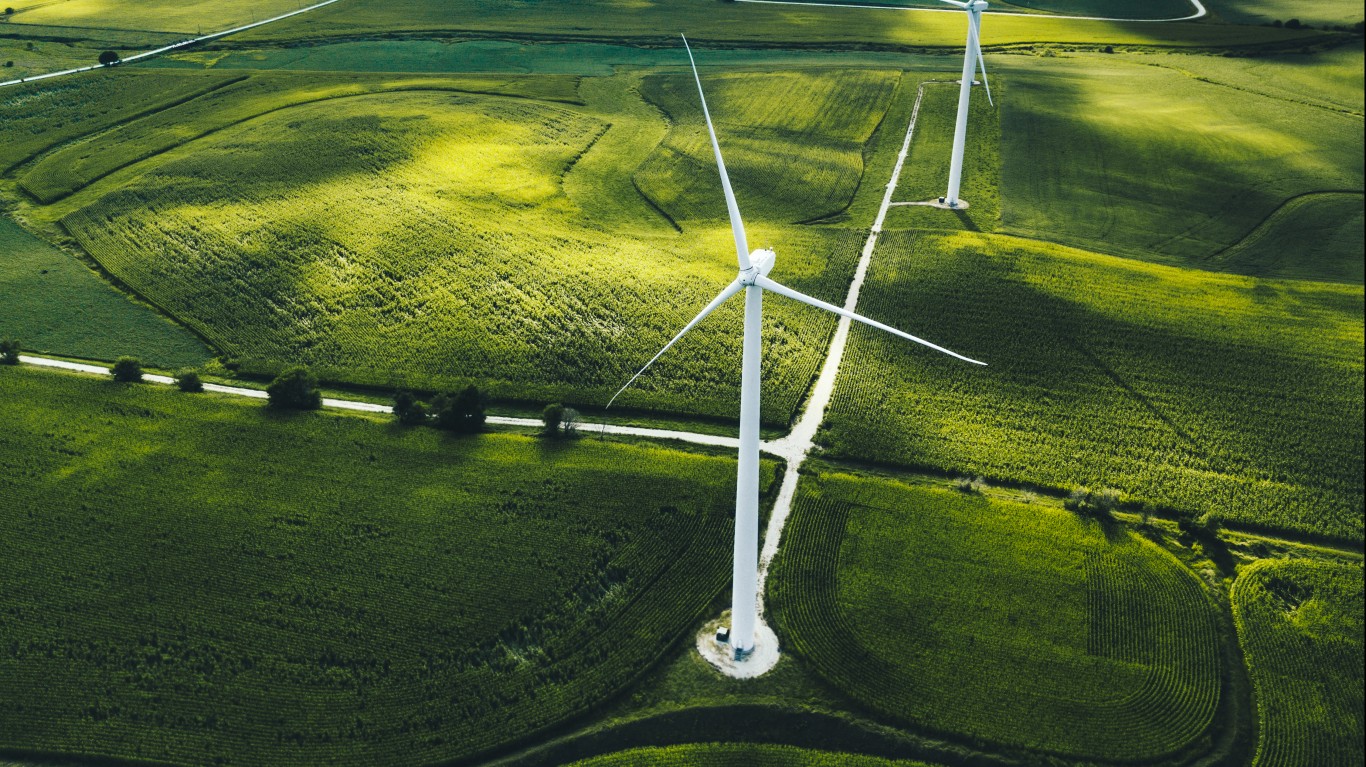
Though the number of clean energy jobs declined during pandemic year 2020, such jobs have surged in recent years, reaching about 3.36 million the year before the pandemic, according to E2’s recent Clean Jobs America report. The number of people employed in clean energy jobs is nearly three times the number of people employed in fossil fuel extraction and generation.
About two-thirds of clean energy jobs are related to energy efficiency and include workers in buildings, those involved in producing Energy Star appliances and energy efficient lighting, and heating and cooling. About half a million jobs are in renewable energy such as solar and wind. The remaining jobs are in the clean vehicles, grid and storage, and fuel subsectors.
The entire country is benefitting from these mostly blue collar jobs, with California, Florida, New York, and Texas having the largest green workforces. The pay is good, too, averaging $23.89 per hour in 2019, about 25% higher than the median wage.
To find the states adding the most clean energy jobs, 24/7 Wall St. reviewed E2’s 2021 Clean Jobs America report. States are ranked by job growth in the three years from 2018 to 2020. E2 is a nonpartisan group advocating for environmental policies.
Clean energy jobs did not grow uniformly in all states. While they grew by 6% nationwide in the three-year period to $3.05 million (despite a 9.1% decline in 2020), they grew by as much as 38.9% in the state with the largest growth. In the top five states, clean energy jobs grew at a double-digit pace. (Here are the American cities that added jobs during the pandemic.)
Though Vermont had the slowest growth in clean energy jobs at 0.8%, the state has the largest share of its workforce employed in such jobs, at 5.37%. The most populous state, California, employs the most people in clean energy jobs, at nearly half a million. (This is how much renewable energy your state produces.)
The number of these jobs will continue to increase in the foreseeable future as the world focuses on climate change. With the growing numbers of national and municipal governments pledging to reach carbon neutrality by 2050, there is a worldwide drive toward non-carbon energy solutions.
Spurred by emerging clean energy policies and by both public and private assistance, clean energy is already becoming increasingly economically competitive. By 2025, it will be cheaper to build new solar and wind power sources than to continue operating most existing coal plants, according to research from Energy Innovation and Vibrant Clean Energy.
Click here to see the states adding the most clean energy jobs
Click here to read our detailed methodology

50. Vermont
> Clean energy employment growth 2018-2020: 0.80% — the lowest
> Clean energy jobs lost in 2020: 1,397 (-8.40% — 19th highest)
> Clean energy jobs recovered — Jun-Dec 2020 growth: 9.70% — 21st lowest
> Total employment in clean energy: 15,238 — 13th lowest
> Pct. working in clean energy of state workforce: 5.37% — the highest
[in-text-ad]

49. California
> Clean energy employment growth 2018-2020: 2.20% — 2nd lowest
> Clean energy jobs lost in 2020: 51,939 (-9.70% — 22nd lowest)
> Clean energy jobs recovered — Jun-Dec 2020 growth: 13.50% — 12th highest
> Total employment in clean energy: 484,980 — the highest
> Pct. working in clean energy of state workforce: 3.01% — 6th highest

48. Wisconsin
> Clean energy employment growth 2018-2020: 2.80% — 3rd lowest
> Clean energy jobs lost in 2020: 7,342 (-9.60% — 24th lowest)
> Clean energy jobs recovered — Jun-Dec 2020 growth: 6.20% — 9th lowest
> Total employment in clean energy: 69,343 — 17th highest
> Pct. working in clean energy of state workforce: 2.52% — 14th highest

47. Delaware
> Clean energy employment growth 2018-2020: 3.30% — 5th lowest
> Clean energy jobs lost in 2020: 1,964 (-14.10% — 4th lowest)
> Clean energy jobs recovered — Jun-Dec 2020 growth: 5.60% — 4th lowest
> Total employment in clean energy: 11,979 — 9th lowest
> Pct. working in clean energy of state workforce: 2.79% — 9th highest
[in-text-ad-2]

46. Wyoming
> Clean energy employment growth 2018-2020: 3.30% — 5th lowest
> Clean energy jobs lost in 2020: 679 (-7.80% — 14th highest)
> Clean energy jobs recovered — Jun-Dec 2020 growth: 5.30% — 3rd lowest
> Total employment in clean energy: 8,042 — 2nd lowest
> Pct. working in clean energy of state workforce: 3.05% — 5th highest

45. Michigan
> Clean energy employment growth 2018-2020: 3.40% — 7th lowest
> Clean energy jobs lost in 2020: 11,909 (-9.50% — 25th lowest)
> Clean energy jobs recovered — Jun-Dec 2020 growth: 20.40% — 5th highest
> Total employment in clean energy: 113,456 — 6th highest
> Pct. working in clean energy of state workforce: 2.81% — 8th highest
[in-text-ad]

44. Rhode Island
> Clean energy employment growth 2018-2020: 3.40% — 7th lowest
> Clean energy jobs lost in 2020: 2,555 (-15.60% — the lowest)
> Clean energy jobs recovered — Jun-Dec 2020 growth: 10.60% — 24th highest
> Total employment in clean energy: 13,874 — 12th lowest
> Pct. working in clean energy of state workforce: 3.07% — 4th highest

43. Maryland
> Clean energy employment growth 2018-2020: 3.50% — 8th lowest
> Clean energy jobs lost in 2020: 6,707 (-7.90% — 15th highest)
> Clean energy jobs recovered — Jun-Dec 2020 growth: 8.20% — 15th lowest
> Total employment in clean energy: 77,842 — 13th highest
> Pct. working in clean energy of state workforce: 3.12% — 3rd highest

42. Oregon
> Clean energy employment growth 2018-2020: 3.60% — 10th lowest
> Clean energy jobs lost in 2020: 4,467 (-7.90% — 15th highest)
> Clean energy jobs recovered — Jun-Dec 2020 growth: 10.60% — 24th highest
> Total employment in clean energy: 52,150 — 21st highest
> Pct. working in clean energy of state workforce: 2.84% — 7th highest
[in-text-ad-2]

41. Massachusetts
> Clean energy employment growth 2018-2020: 3.60% — 10th lowest
> Clean energy jobs lost in 2020: 13,568 (-11.10% — 10th lowest)
> Clean energy jobs recovered — Jun-Dec 2020 growth: 5.90% — 7th lowest
> Total employment in clean energy: 108,909 — 7th highest
> Pct. working in clean energy of state workforce: 3.29% — 2nd highest

40. Washington
> Clean energy employment growth 2018-2020: 3.80% — 11th lowest
> Clean energy jobs lost in 2020: 9,351 (-11.00% — 11th lowest)
> Clean energy jobs recovered — Jun-Dec 2020 growth: 18.60% — 6th highest
> Total employment in clean energy: 75,684 — 14th highest
> Pct. working in clean energy of state workforce: 2.32% — 20th highest
[in-text-ad]

39. Tennessee
> Clean energy employment growth 2018-2020: 3.90% — 12th lowest
> Clean energy jobs lost in 2020: 6,674 (-8.40% — 19th highest)
> Clean energy jobs recovered — Jun-Dec 2020 growth: 5.70% — 5th lowest
> Total employment in clean energy: 72,952 — 15th highest
> Pct. working in clean energy of state workforce: 2.50% — 15th highest

38. Missouri
> Clean energy employment growth 2018-2020: 4.00% — 13th lowest
> Clean energy jobs lost in 2020: 4,916 (-8.70% — 21st highest)
> Clean energy jobs recovered — Jun-Dec 2020 growth: 9.30% — 18th lowest
> Total employment in clean energy: 51,570 — 22nd highest
> Pct. working in clean energy of state workforce: 1.92% — 18th lowest

37. Connecticut
> Clean energy employment growth 2018-2020: 4.40% — 15th lowest
> Clean energy jobs lost in 2020: 2,557 (-6.00% — 5th highest)
> Clean energy jobs recovered — Jun-Dec 2020 growth: 11.10% — 22nd highest
> Total employment in clean energy: 39,898 — 25th lowest
> Pct. working in clean energy of state workforce: 2.56% — 13th highest
[in-text-ad-2]

36. South Dakota
> Clean energy employment growth 2018-2020: 4.40% — 15th lowest
> Clean energy jobs lost in 2020: 51 (-0.40% — the highest)
> Clean energy jobs recovered — Jun-Dec 2020 growth: 9.20% — 17th lowest
> Total employment in clean energy: 11,406 — 7th lowest
> Pct. working in clean energy of state workforce: 2.70% — 12th highest

35. Indiana
> Clean energy employment growth 2018-2020: 4.70% — 16th lowest
> Clean energy jobs lost in 2020: 6,278 (-7.20% — 9th highest)
> Clean energy jobs recovered — Jun-Dec 2020 growth: 12.50% — 15th highest
> Total employment in clean energy: 80,614 — 12th highest
> Pct. working in clean energy of state workforce: 2.74% — 10th highest
[in-text-ad]

34. Hawaii
> Clean energy employment growth 2018-2020: 5.00% — 17th lowest
> Clean energy jobs lost in 2020: 1,378 (-9.90% — 20th lowest)
> Clean energy jobs recovered — Jun-Dec 2020 growth: 31.90% — the highest
> Total employment in clean energy: 12,550 — 11th lowest
> Pct. working in clean energy of state workforce: 2.47% — 17th highest

33. Arkansas
> Clean energy employment growth 2018-2020: 5.10% — 19th lowest
> Clean energy jobs lost in 2020: 1,570 (-7.70% — 12th highest)
> Clean energy jobs recovered — Jun-Dec 2020 growth: 9.50% — 20th lowest
> Total employment in clean energy: 18,807 — 17th lowest
> Pct. working in clean energy of state workforce: 1.59% — 7th lowest

32. New Hampshire
> Clean energy employment growth 2018-2020: 5.10% — 19th lowest
> Clean energy jobs lost in 2020: 1,248 (-7.50% — 11th highest)
> Clean energy jobs recovered — Jun-Dec 2020 growth: 3.00% — the lowest
> Total employment in clean energy: 15,323 — 14th lowest
> Pct. working in clean energy of state workforce: 2.42% — 18th highest
[in-text-ad-2]

31. Alaska
> Clean energy employment growth 2018-2020: 5.20% — 22nd lowest
> Clean energy jobs lost in 2020: 780 (-13.90% — 5th lowest)
> Clean energy jobs recovered — Jun-Dec 2020 growth: 17.10% — 8th highest
> Total employment in clean energy: 4,848 — the lowest
> Pct. working in clean energy of state workforce: 1.60% — 8th lowest

30. North Carolina
> Clean energy employment growth 2018-2020: 5.20% — 22nd lowest
> Clean energy jobs lost in 2020: 13,050 (-11.60% — 9th lowest)
> Clean energy jobs recovered — Jun-Dec 2020 growth: 16.60% — 9th highest
> Total employment in clean energy: 99,670 — 9th highest
> Pct. working in clean energy of state workforce: 2.31% — 21st highest
[in-text-ad]

29. Mississippi
> Clean energy employment growth 2018-2020: 5.20% — 22nd lowest
> Clean energy jobs lost in 2020: 2,235 (-10.60% — 13th lowest)
> Clean energy jobs recovered — Jun-Dec 2020 growth: 11.70% — 19th highest
> Total employment in clean energy: 18,750 — 16th lowest
> Pct. working in clean energy of state workforce: 1.72% — 12th lowest

28. North Dakota
> Clean energy employment growth 2018-2020: 5.80% — 25th highest
> Clean energy jobs lost in 2020: 934 (-10.20% — 15th lowest)
> Clean energy jobs recovered — Jun-Dec 2020 growth: 12.50% — 15th highest
> Total employment in clean energy: 8,258 — 3rd lowest
> Pct. working in clean energy of state workforce: 2.07% — 24th highest

27. Nebraska
> Clean energy employment growth 2018-2020: 5.80% — 25th highest
> Clean energy jobs lost in 2020: 1,594 (-8.20% — 17th highest)
> Clean energy jobs recovered — Jun-Dec 2020 growth: 11.60% — 20th highest
> Total employment in clean energy: 17,846 — 15th lowest
> Pct. working in clean energy of state workforce: 1.88% — 17th lowest
[in-text-ad-2]

26. Illinois
> Clean energy employment growth 2018-2020: 5.80% — 25th highest
> Clean energy jobs lost in 2020: 10,230 (-8.20% — 17th highest)
> Clean energy jobs recovered — Jun-Dec 2020 growth: 6.70% — 11th lowest
> Total employment in clean energy: 115,133 — 5th highest
> Pct. working in clean energy of state workforce: 2.07% — 24th highest

25. Virginia
> Clean energy employment growth 2018-2020: 5.80% — 25th highest
> Clean energy jobs lost in 2020: 8,935 (-9.20% — 24th highest)
> Clean energy jobs recovered — Jun-Dec 2020 growth: 6.50% — 10th lowest
> Total employment in clean energy: 88,370 — 10th highest
> Pct. working in clean energy of state workforce: 2.36% — 19th highest
[in-text-ad]

24. South Carolina
> Clean energy employment growth 2018-2020: 6.00% — 22nd highest
> Clean energy jobs lost in 2020: 4,639 (-10.00% — 17th lowest)
> Clean energy jobs recovered — Jun-Dec 2020 growth: 13.70% — 11th highest
> Total employment in clean energy: 41,888 — 24th highest
> Pct. working in clean energy of state workforce: 2.07% — 24th highest

23. Minnesota
> Clean energy employment growth 2018-2020: 6.00% — 22nd highest
> Clean energy jobs lost in 2020: 6,477 (-10.50% — 14th lowest)
> Clean energy jobs recovered — Jun-Dec 2020 growth: 10.10% — 23rd lowest
> Total employment in clean energy: 55,329 — 20th highest
> Pct. working in clean energy of state workforce: 2.05% — 24th lowest

22. Iowa
> Clean energy employment growth 2018-2020: 6.00% — 22nd highest
> Clean energy jobs lost in 2020: 3,103 (-9.70% — 22nd lowest)
> Clean energy jobs recovered — Jun-Dec 2020 growth: 8.20% — 15th lowest
> Total employment in clean energy: 28,953 — 21st lowest
> Pct. working in clean energy of state workforce: 1.96% — 19th lowest
[in-text-ad-2]

21. Ohio
> Clean energy employment growth 2018-2020: 6.40% — 21st highest
> Clean energy jobs lost in 2020: 10,951 (-9.60% — 24th lowest)
> Clean energy jobs recovered — Jun-Dec 2020 growth: 10.10% — 23rd lowest
> Total employment in clean energy: 103,437 — 8th highest
> Pct. working in clean energy of state workforce: 2.01% — 21st lowest

20. Alabama
> Clean energy employment growth 2018-2020: 6.60% — 20th highest
> Clean energy jobs lost in 2020: 4,342 (-9.90% — 20th lowest)
> Clean energy jobs recovered — Jun-Dec 2020 growth: 13.30% — 13th highest
> Total employment in clean energy: 39,486 — 24th lowest
> Pct. working in clean energy of state workforce: 2.08% — 23rd highest
[in-text-ad]

19. Arizona
> Clean energy employment growth 2018-2020: 7.40% — 18th highest
> Clean energy jobs lost in 2020: 5,602 (-9.00% — 23rd highest)
> Clean energy jobs recovered — Jun-Dec 2020 growth: 7.00% — 12th lowest
> Total employment in clean energy: 56,504 — 19th highest
> Pct. working in clean energy of state workforce: 2.02% — 22nd lowest

18. Utah
> Clean energy employment growth 2018-2020: 7.40% — 18th highest
> Clean energy jobs lost in 2020: 2,491 (-5.70% — 4th highest)
> Clean energy jobs recovered — Jun-Dec 2020 growth: 3.80% — 2nd lowest
> Total employment in clean energy: 41,514 — 25th highest
> Pct. working in clean energy of state workforce: 2.73% — 11th highest

17. Montana
> Clean energy employment growth 2018-2020: 7.50% — 17th highest
> Clean energy jobs lost in 2020: 917 (-8.80% — 22nd highest)
> Clean energy jobs recovered — Jun-Dec 2020 growth: 11.40% — 21st highest
> Total employment in clean energy: 9,460 — 5th lowest
> Pct. working in clean energy of state workforce: 2.03% — 23rd lowest
[in-text-ad-2]

16. Kentucky
> Clean energy employment growth 2018-2020: 7.90% — 16th highest
> Clean energy jobs lost in 2020: 5,116 (-13.40% — 6th lowest)
> Clean energy jobs recovered — Jun-Dec 2020 growth: 26.80% — 3rd highest
> Total employment in clean energy: 33,150 — 23rd lowest
> Pct. working in clean energy of state workforce: 1.83% — 15th lowest

15. Kansas
> Clean energy employment growth 2018-2020: 8.00% — 15th highest
> Clean energy jobs lost in 2020: 2,336 (-9.40% — 25th highest)
> Clean energy jobs recovered — Jun-Dec 2020 growth: 5.90% — 7th lowest
> Total employment in clean energy: 22,572 — 19th lowest
> Pct. working in clean energy of state workforce: 1.70% — 11th lowest
[in-text-ad]

14. Maine
> Clean energy employment growth 2018-2020: 8.10% — 14th highest
> Clean energy jobs lost in 2020: 875 (-6.80% — 6th highest)
> Clean energy jobs recovered — Jun-Dec 2020 growth: 12.40% — 17th highest
> Total employment in clean energy: 11,922 — 8th lowest
> Pct. working in clean energy of state workforce: 2.00% — 20th lowest

13. New York
> Clean energy employment growth 2018-2020: 8.70% — 13th highest
> Clean energy jobs lost in 2020: 6,129 (-3.80% — 2nd highest)
> Clean energy jobs recovered — Jun-Dec 2020 growth: 10.50% — 25th lowest
> Total employment in clean energy: 153,208 — 3rd highest
> Pct. working in clean energy of state workforce: 1.79% — 13th lowest

12. New Mexico
> Clean energy employment growth 2018-2020: 9.10% — 12th highest
> Clean energy jobs lost in 2020: 1,249 (-10.10% — 16th lowest)
> Clean energy jobs recovered — Jun-Dec 2020 growth: 13.20% — 14th highest
> Total employment in clean energy: 11,116 — 6th lowest
> Pct. working in clean energy of state workforce: 1.44% — 4th lowest
[in-text-ad-2]

11. Idaho
> Clean energy employment growth 2018-2020: 9.20% — 10th highest
> Clean energy jobs lost in 2020: 636 (-4.80% — 3rd highest)
> Clean energy jobs recovered — Jun-Dec 2020 growth: 10.80% — 23rd highest
> Total employment in clean energy: 12,545 — 10th lowest
> Pct. working in clean energy of state workforce: 1.64% — 9th lowest

10. Texas
> Clean energy employment growth 2018-2020: 9.20% — 10th highest
> Clean energy jobs lost in 2020: 17,882 (-7.40% — 10th highest)
> Clean energy jobs recovered — Jun-Dec 2020 growth: 7.20% — 13th lowest
> Total employment in clean energy: 223,406 — 2nd highest
> Pct. working in clean energy of state workforce: 1.87% — 16th lowest
[in-text-ad]

9. Pennsylvania
> Clean energy employment growth 2018-2020: 9.60% — 7th highest
> Clean energy jobs lost in 2020: 6,548 (-7.00% — 8th highest)
> Clean energy jobs recovered — Jun-Dec 2020 growth: 20.90% — 4th highest
> Total employment in clean energy: 87,313 — 11th highest
> Pct. working in clean energy of state workforce: 1.59% — 7th lowest

8. Florida
> Clean energy employment growth 2018-2020: 9.60% — 7th highest
> Clean energy jobs lost in 2020: 16,408 (-9.90% — 20th lowest)
> Clean energy jobs recovered — Jun-Dec 2020 growth: 12.00% — 18th highest
> Total employment in clean energy: 149,624 — 4th highest
> Pct. working in clean energy of state workforce: 1.80% — 14th lowest

7. Colorado
> Clean energy employment growth 2018-2020: 9.60% — 7th highest
> Clean energy jobs lost in 2020: 4,238 (-6.80% — 6th highest)
> Clean energy jobs recovered — Jun-Dec 2020 growth: 6.00% — 8th lowest
> Total employment in clean energy: 58,182 — 18th highest
> Pct. working in clean energy of state workforce: 2.24% — 22nd highest
[in-text-ad-2]

6. Georgia
> Clean energy employment growth 2018-2020: 9.90% — 6th highest
> Clean energy jobs lost in 2020: 12,695 (-15.10% — 3rd lowest)
> Clean energy jobs recovered — Jun-Dec 2020 growth: 29.60% — 2nd highest
> Total employment in clean energy: 71,111 — 16th highest
> Pct. working in clean energy of state workforce: 1.66% — 10th lowest

5. West Virginia
> Clean energy employment growth 2018-2020: 10.30% — 5th highest
> Clean energy jobs lost in 2020: 1,081 (-10.70% — 12th lowest)
> Clean energy jobs recovered — Jun-Dec 2020 growth: 9.50% — 20th lowest
> Total employment in clean energy: 8,996 — 4th lowest
> Pct. working in clean energy of state workforce: 1.39% — 3rd lowest
[in-text-ad]

4. Oklahoma
> Clean energy employment growth 2018-2020: 10.70% — 4th highest
> Clean energy jobs lost in 2020: 2,633 (-11.60% — 9th lowest)
> Clean energy jobs recovered — Jun-Dec 2020 growth: 14.90% — 10th highest
> Total employment in clean energy: 20,132 — 18th lowest
> Pct. working in clean energy of state workforce: 1.31% — the lowest

3. New Jersey
> Clean energy employment growth 2018-2020: 10.80% — 3rd highest
> Clean energy jobs lost in 2020: 7,043 (-12.30% — 7th lowest)
> Clean energy jobs recovered — Jun-Dec 2020 growth: 10.50% — 25th lowest
> Total employment in clean energy: 50,096 — 23rd highest
> Pct. working in clean energy of state workforce: 1.33% — 2nd lowest

2. Louisiana
> Clean energy employment growth 2018-2020: 11.60% — 2nd highest
> Clean energy jobs lost in 2020: 4,716 (-15.20% — 2nd lowest)
> Clean energy jobs recovered — Jun-Dec 2020 growth: 17.50% — 7th highest
> Total employment in clean energy: 26,393 — 20th lowest
> Pct. working in clean energy of state workforce: 1.52% — 5th lowest
[in-text-ad-2]

1. Nevada
> Clean energy employment growth 2018-2020: 38.90% — the highest
> Clean energy jobs lost in 2020: 2,597 (-7.70% — 12th highest)
> Clean energy jobs recovered — Jun-Dec 2020 growth: 8.40% — 16th lowest
> Total employment in clean energy: 31,191 — 22nd lowest
> Pct. working in clean energy of state workforce: 2.49% — 16th highest
Methodology
To find the states adding the most clean energy jobs, 24/7 Wall St. reviewed E2’s 2021 Clean Jobs America report. States are ranked by job growth in the three years from 2018 to 2020. The analysis is based on preliminary employment data from the 2021 U.S. Energy and Employment Report, which uses Bureau of Labor Statistics data.
Clean energy employment spans economic sectors and includes jobs in renewable energy, solar and wind, storage and grid, energy efficiency, clean fuels, and clean vehicles. E2 does not include jobs in corn ethanol, woody biomass, large hydropower, and nuclear. Similarly, jobs in retail trade, repair services, water or waste management, and indirect employment or induced employment are not included.
Cash Back Credit Cards Have Never Been This Good
Credit card companies are at war, handing out free rewards and benefits to win the best customers. A good cash back card can be worth thousands of dollars a year in free money, not to mention other perks like travel, insurance, and access to fancy lounges. See our top picks for the best credit cards today. You won’t want to miss some of these offers.
Flywheel Publishing has partnered with CardRatings for our coverage of credit card products. Flywheel Publishing and CardRatings may receive a commission from card issuers.
Thank you for reading! Have some feedback for us?
Contact the 24/7 Wall St. editorial team.
 24/7 Wall St.
24/7 Wall St. 24/7 Wall St.
24/7 Wall St. 24/7 Wall St.
24/7 Wall St.

